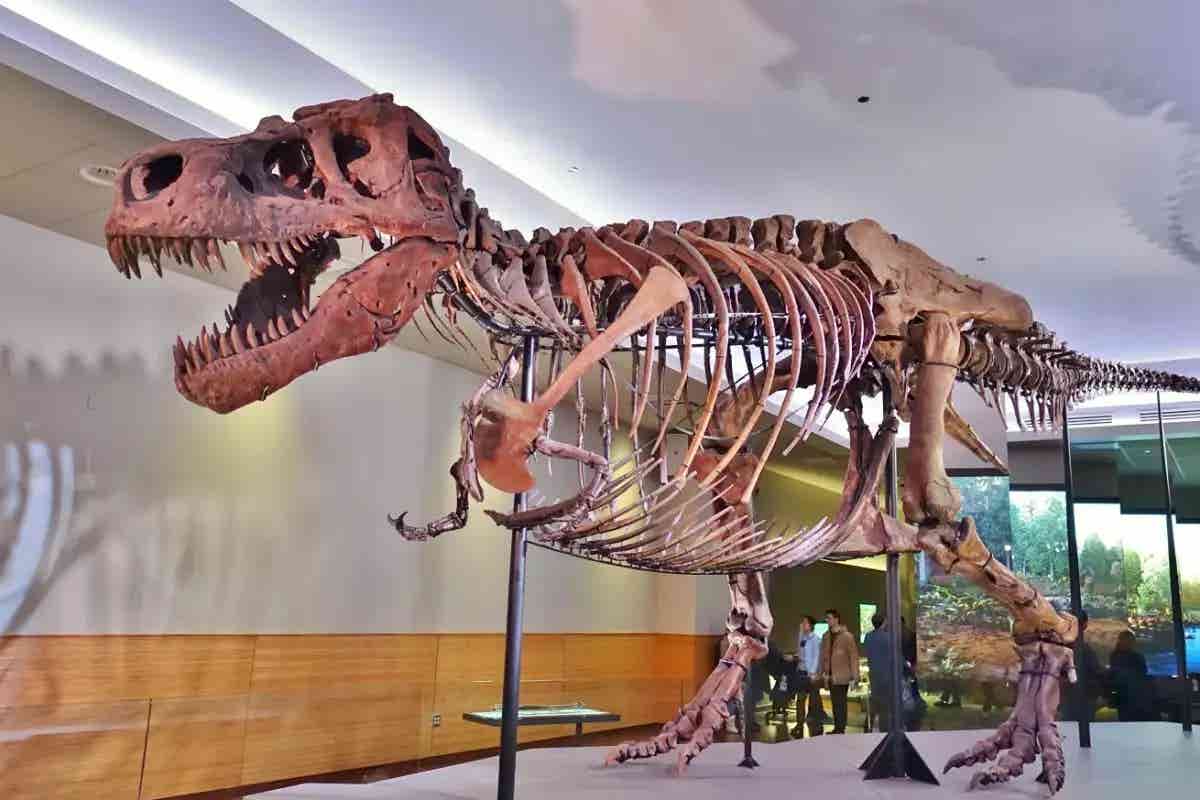How smart was the T. Rex? New study yields surprising results
For decades, paleontologists have attempted to understand dinosaur behavior by studying their brain size and structure.

Sue, the Tyrannosaurus skeleton at the Field Museum in Chicago. (CREDIT: EQRoy / Alamy)
For decades, paleontologists have attempted to understand dinosaur behavior by studying their brain size and structure. Previous research suggested dinosaurs possessed high intelligence, comparable to primates. However, a new study published in The Anatomical Record by an international team challenges this notion.
The earlier study, published in 2023, proposed a revolutionary idea – dinosaurs, particularly large theropods like Tyrannosaurus Rex (T. rex), might have boasted exceptional cognitive abilities.
This conclusion stemmed from estimates of high neuron counts in their brains, implying intelligence comparable to monkeys. The study even suggested these dinosaurs engaged in tool use and transmitted knowledge culturally, behaviors typically associated with higher intelligence.
Simplified phylogeny of the Sauropsida (= total group Reptilia) with a focus on the taxon Ornithodira (the least inclusive clade containing pterosaurs and dinosaurs, see revised definition of Nesbitt, 2011) and schematic representative color-coded brain morphologies, excluding the pituitary (not to scale). (CREDIT: The Anatomical Record)
However, the latest research led by Dr. Kai Caspar (Heinrich Heine University) alongside Dr. Cristian Gutierrez-Ibanez (University of Alberta), Dr. Grant Hurlburt (Royal Ontario Museum), Dr. Darren Naish (University of Southampton), and Hady George (University of Bristol) sheds doubt on these claims.
The team meticulously re-evaluated the methods used to estimate brain size and neuron numbers in dinosaurs.
Traditionally, paleontologists relied on two primary sources of information:
Endocasts: Mineral fillings replicating the shape of the brain cavity within the fossilized skull.
Brain cavity shape: Direct observations of the empty cavity itself.
Related Stories
These methods, the new study argues, led to overestimations, particularly concerning the size of the forebrain – a region associated with higher cognitive functions in living animals. Consequently, the number of neurons within these brains was also likely overestimated.
This challenges the direct correlation between neuron counts and intelligence. The researchers emphasize the need for a multifaceted approach when reconstructing the behavior and cognitive abilities of extinct creatures.
This includes:
Skeletal Anatomy: Examining bone structure for clues about movement patterns and sensory capabilities.
Bone Histology: Studying the microscopic structure of bones can reveal information about growth rates and metabolism.
Behavior of Living Relatives: Observing the behavior of present-day reptiles and birds, considered evolutionary descendants of dinosaurs, can offer insights into potential dinosaur behavior.
Trace Fossils: Studying footprints, burrows, and other non-body fossils can reveal aspects of dinosaur behavior.
“Relying solely on estimated neuron numbers is inadequate for determining intelligence in extinct animals like dinosaurs,” explains Hady George from the University of Bristol. “A more comprehensive approach, encompassing everything from gross anatomy to fossil footprints, paints a clearer picture.”
Dr. Kai Caspar echoes this sentiment. “Using endocast-derived neuron count estimates to predict intelligence in extinct species is simply not a sound practice.”
Dr. Ornella Bertrand (Institut Català de Paleontologia Miquel Crusafont) adds, “Neuron counts are unreliable indicators of cognitive ability. Basing intelligence estimates on these numbers for long-extinct species leads to misleading interpretations.”
Relationship between brain and body mass in land-living vertebrates. Dinosaurs like T. rex have brain to body size ratios similar to those of living reptiles. (CREDIT: Cristian Gutierrez-Ibanez)
The earlier suggestion that T. rex might have possessed baboon-like intelligence was undeniably captivating, offering a glimpse into a radically different dinosaurian past.
“However,” concludes Dr. Darren Naish, “our research demonstrates a lack of evidence for such claims. While not possessing primate-level intelligence, dinosaurs might have been remarkably intelligent giant crocodiles – a concept equally fascinating.”
This new study underscores the importance of methodological rigor and a holistic approach when reconstructing the lives of extinct creatures. By moving beyond simplistic estimates of brain size and neuron numbers, paleontologists can paint a more nuanced picture of dinosaur behavior and intelligence.
For more science news stories check out our New Discoveries section at The Brighter Side of News.
Note: Materials provided above by The Brighter Side of News. Content may be edited for style and length.
Like these kind of feel good stories? Get the Brighter Side of News' newsletter.
Joshua Shavit
Science & Technology Writer | AI and Robotics Reporter
Joshua Shavit is a Los Angeles-based science and technology writer with a passion for exploring the breakthroughs shaping the future. As a contributor to The Brighter Side of News, he focuses on positive and transformative advancements in AI, technology, physics, engineering, robotics and space science. Joshua is currently working towards a Bachelor of Science in Business Administration at the University of California, Berkeley. He combines his academic background with a talent for storytelling, making complex scientific discoveries engaging and accessible. His work highlights the innovators behind the ideas, bringing readers closer to the people driving progress.



